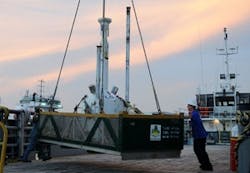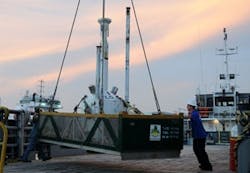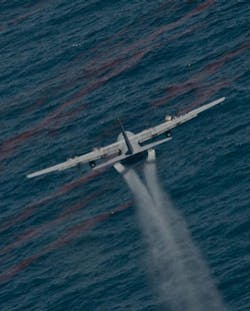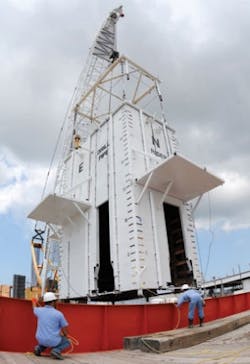BP PLC executives planned to contain the oil spill in the Gulf of Mexico using a small containment structure, which they call a top hat.
At presstime last week, the top hat, measuring 4 ft in diameter and 5 ft tall, was on the seabed. A BP spokesman estimated the containment system might be operational by May 14-15.
Simultaneously, BP worked to stop the flow of oil from a deepwater well off Louisiana by plugging up the blowout preventer in 5,000 ft of water and then sealing the wellhead.
The number of federal scientists and engineers working in command centers along the Gulf Coast escalated while US President Barack Obama sent Cabinet-level officials to talk with BP executives.
Speaking from Houston on May 12, Department of the Interior Secretary Ken Salazar said, "This is a vital national priority and we cannot and will not rest until BP has capped the well and controlled the spill."
Hundreds of technical experts and operating specialists from various companies and countries worked on multiple options in parallel at BP's Houston offices.
"We continue to fight this very aggressively," BP PLC Chief Executive Tony Hayward told reporters May 10 in Houston. "The learning from this will be very extensive."
An oil spill containment chamber, called the "top hat," is loaded onto a vessel at Wild Well Control Inc. in Port Fourchon, La. US Coast Guard photo by Petty Officer 3rd Class Patrick Kelley.
As of May 13, BP said it spent $450 million on spill response efforts at the ocean's surface, subsea containment efforts, relief well drilling, and payments to Louisiana, Alabama, Mississippi, and Florida.
BP and partners hired Transocean Ltd.'s semisubmersible rig, Deepwater Horizon, to drill the Macondo well on Mississippi Canyon Block 252. The Deepwater Horizon exploded Apr. 20, leaving 11 crew members missing and presumed dead. On Apr. 22, the Deepwater Horizon sank (OGJ, May 3, 2010, p. 31).
The oil and gas well is spilling an estimated 5,000 b/d. BP is the operator with 65% interest. Partners are Anadarko Petroleum Corp., 25%, and Mitsui Oil Exploration Co. Ltd., 10%.
Containment options
On May 9, BP set aside a large containment dome that it had hoped to place over a damaged, leaking riser on the seabed because gas hydrates built up in the dome, which then tried to float.
Engineers had hoped the 98-ton dome could capture an estimated 85% of the leaking oil and gas, which then was to be pumped to a drillship on the surface (OGJ, May 10, 2010, p. 23).
A US Air Force C-130 sprays chemical dispersant on the Deepwater Horizon oil spill in the Gulf of Mexico. US Air Force photo by Tech. Sgt. Adrian Cadiz.
"We learned primarily that there is a lot more gas involved in this leak than we had believed," Hayward said.
The idea behind the smaller top hat was to prevent the leaking oil and gas from contacting the seawater., which is 30° F. at 5,000 ft.
The top hat involves two possible options, one is the top hat collection device and the second is a riser insertion tube that might be inserted into the damaged Deepwater Horizon riser, said Doug Suttles, chief operating officer of BP Exploration & Production, from Roberta, La., on May 12.
The riser insertion tube would prevent leaking hydrocarbons from contacting seawater and forming hydrates, Suttles said.
All top hat-related equipment was being put in place while engineers and scientists determined the best option, Suttles said.
Engineers believe the amount of sea water in the first, large containment dome contributed to the formation of more gas hydrates than had been anticipated.
The US Minerals Management Service approved the use of methanol in conjunction with the top hat to prevent the formation of hydrates. Warm seawater from the surface also is going to be pumped along the riser bringing the collected oil and gas to the surface.
"It will be a little trickier for us, but we will make it work," Kent Wells, BP senior vice-president of exploration and production, said on May 10 of the top hat method vs. the larger dome. "There are always some pros and cons to everything we try."
Wells said some pipes will be placed into the seafloor to help secure the top hat containment device.
Top kill technique
In what is known as a "top kill" or a "junk shot," BP planned to first plug the BOP by shooting various items including cut-up tires, ropes with knots, and golf balls into the internal workings of the BOP to seal it.
Crewmen guide a containment system onto the deck as the ship prepares to depart. The system was designed to contain the oil discharge before it reached the surface. USCG photo by Petty Officer 3rd Class Patrick Kelley.
A pipe from the surface will be hooked to the BOP so that junk can be shot inside it.
"We can give this several shots," if needed, Wells said. "The No. 1 priority is to shut off the flow of oil."
Immediately upon plugging the inside of the BOP, BP plans to use existing choke and kill lines running along the BOP to send heavy fluid at high pressure into the wellhead to push the oil and gas back into the reservoir. Eventually, cement will be sent into the well to seal and permanently abandon the well.
In describing the technique to reporters, Wells noted many unknowns exist. "We've never had a blowout before at 5,000 ft."
Previously, BP used remotely operated vehicles to retrieve the control pod from the BOP. The control pod's electronics are being refurbished to send electric signals to the choke and kill lines on the BOP stack. Wells said he expects the junk shot can be done within 2 weeks.
"Whatever we try, we want to make sure it's not going to make things worse," Wells said. "We really believe it's going to plug up the BOP. There are a lot of different steps to do. We will put whatever pressure it takes into the well," to stop the flow of oil and gas.
Meanwhile, one relief well is being drilled, and a second relief well will be drilled as a backup to the first relief well in case the first relief well were to run into problems.
Drilling of the first relief well started May 2 and is expected to take up to 90 days. It had reached 9,000 ft of its total 18,000 ft as of May 10, Hayward said.
Drilling of the second relief well was scheduled to start on May 14.
In other spill response efforts, BP applied chemical dispersants on the subsea oil leaks to help break up the oil so that it can degrade before reaching the surface. Meanwhile, controlled burns are being done on open water to eliminate some of the oil slick before it reaches shore.
Skimming vessels and booms also are being used to prevent much of the oil from reaching shore. Airplanes are spraying chemical dispersants on oil after it reaches the water's surface.
The US Coast Guard on May 12 reported more than 517 vessels were involved in the cleanup response. More than 1.5 million ft of boom was deployed, and about 4 million gal of oily water has been recovered.
Teams had used about 436,250 gal of chemical dispersants to help degrade the spilled oil, and some 13,000 people were involved in the oil spill response.
Leaders of the National Park Service and the National Wildlife Refuge system worked from command centers along the Gulf Coast to protect the shoreline.
Oil from the spill has been confirmed washing up on Alabama's Dauphin Island as well as on Chandeleur Islands, a chain of barrier islands off Louisiana.
USCG-MMS joint hearing
USCG and MMS called witnesses during a May 11-12 public hearing starting May 11 in Kenner, La. The hearing concerns a joint investigation by USCG and MMS to identify factors leading to the rig accident and subsequent oil spill.
USCG Comm. Adm. Thad W. Allen, MMS Director S. Elizabeth Birnbaum, Department of Homeland Security Secretary Janet Napolitano, and Interior Secretary Salazar signed an order convening the joint investigation, which is classified as a Coast Guard Marine Board of Investigation.
Hayward said the Marine Board issued a subpoena for the BOP from the seabed.
USCG and MMS share jurisdiction for the investigation of casualties occurring on the Outer Continental Shelf. Upon completion of the joint investigation, the team will issue a single report simultaneously to both agencies.
Other congressional hearings and investigations into the cause of the accident and spill are ongoing in Washington, DC (see related story, p. 26)
Salazar, Chu visit BP
At Obama's request, Salazar and Secretary of Energy Steven Chu met with BP executives in Houston on May 12.
Chu said, "Department of Energy scientists from the National Laboratories have been working with the operations experts at the BP Command center on ways to determine what is happening inside the BOP atop the damaged wellhead."
Engineers and scientists are using supercomputers to assist with imaging and sampling of the seafloor, measuring pressures in the BOP, and analyzing the riser structure and fluid flows.
"Putting our best scientific minds together with BP's deepwater drilling engineers will enable these dedicated professionals to examine every feasible means and practical solution to this environmental crisis in the Gulf of Mexico," Chu said.
Marcia McNutt, director of the US Geological Survey, also was at the BP offices in Houston to help coordinate the joint efforts of federal scientists working with BP engineers.
More Oil & Gas Journal Current Issue Articles
More Oil & Gas Journal Archives Issue Articles
View Oil and Gas Articles on PennEnergy.com




